8044 THE HAREWOOD HOUSE TORCHÈRES PAIR OF CARVED FAUX BRONZE AND FAUX PORPHYRY TORCHÈRES POSSIBLY BY THOMAS CHIPPENDALE THE YOUNGER English. Circa 1815. Measurements: Height: 61 1/2″ (156 1/4 cm) Width: 19 1/2″ (49 1/2 cm)

Research
Of limewood with mostly original green-painted and faux porphyry decoration. Each surmounted by a circular gadrooned top above a shaped stem with reeded central section and anthemion decoration raised on four winged female figures and a pylon shaped faux porphyry base decorated to each side with a wreath and crossed poles with acorn finials, the whole raised on four bold paw feet and a square faux porphyry plinth with canted corners. Minor restoration to sphinxes and bases.
Published:
Inspired by Antiquity: Classical Influences on 18th and 19th Century Furniture and Works of Art. Carlton Hobbs LLC, 2011.
Provenance:
Harewood House, Yorkshire.
Christie’s House Sale on the premises of Harewood House, 3 October 1988.
The design of this pair of torchères, composed of an inventive synthesis of diverse classical elements, is strongly characteristic of the English Regency style. The form derives from the ancient Roman lamp-stand, or candelabrum, and combines elements from both bronze and marble examples of these lighting devices. Although the shapes varied, the basic elements of a candelabrum were predominantly the same, consisting of a base, a shaft and a top support. Early bronze versions usually included a base in the form of three animal feet; a shaft, slender and often fluted; and a top support, usually consisting of a socket for holding a candle or a plinth on which to place a lamp (figure 1a). Marble candelabra were formed of the same components, but were much more substantial and elaborate in decoration (figure 1b).
The present torchères can be attributed to the celebrated furniture-designer and cabinetmaker Thomas Chippendale the Younger, who was engaged at Harewood House, the great Yorkshire mansion built between 1759 and 1771 by a combination of the architects John Carr and Robert Adam. The Younger’s commission followed the succession of Henry Lascelles, 2nd Earl of Harewood in 1812, when a number of schemes of redecoration were undertaken. His father, Thomas Chippendale the Elder, had been employed at Harewood beginning in the late 1760s in one of his largest commissions, and Chippendale the Younger may have designed some of the pieces produced by his father’s firm.1
The Younger’s interest was scholarly and antiquarian in character, drawing inspiration from the models and motifs of classical antiquity which were gaining a wider currency in England through works such as Charles Heathcote Tatham’s Etchings of Ancient Ornamental Architecture drawn from the Originals in Rome and Other Parts of Italy during the years 1794, 1795, and 1796, first published in 1800. He was greatly influenced by the French neoclassical style of Louis XVI, and summarized his designs in his publication of Sketches of Ornament (1779).2 Chippendale was praised by contemporary designer George Smith for his “great degree of taste, with great ability as a draughtsman and designer,” and was one of the leading figures in the neoclassical revival that dominated the cultural expression of the early nineteenth century.
The bold lion paw feet of the present base are a recurrent motif in Regency design, revived from ancient prototypes popularized by the engravings of the Italian architect Giovanni Battista Piranesi (d.1778) and plaster replicas obtained by the architect Sir John Soane (d.1837) for his London mansion/museum. The faux-bronze bas-relief trophies are composed of crossed thyrsic wands below ribbon-tied wreaths of ivy. The thyrsus, a symbol of fertility, is a staff topped with a pinecone and wound with ivy vines and leaves, carried by Dionysus and his followers. These, like the lion, evoke festivities in antiquity and the triumphs of the wine-deity. The reed-enriched and palmette-decorated pillars are enhanced by a meandering decoration at the top and base of the shaft, a motif that appears in painted representations of Dionysus in the form of vines. The faux porphyry plinths and sphinx monopodiae reflect the concurrent Egyptian fashion of the time, encouraged by the publication of Vivant Denon’s Voyage dans la Basse et la Haute Égypt (Paris, 1802). The sphinxes are closely related to ormolu examples found on a pair of candlesticks in the collection of Philip Hewat-Jaboor possibly made by the Paris bronzier Lefèvre circa 1802 (figure 2). This model, which appears as Plate XLIX in Household Furniture (figure 3), was probably an original French prototype of circa 1802, acquired by Hope in Paris, which he then had copied in London.
This exceptionally sophisticated pair of torchères is identical to a pair in the Victoria and Albert Museum (Inventory Nos. W.27-1951 and W.27A-1951) (figure 4). The latter also originally formed part of the collection of Lascelles. It has been speculated by the Victoria and Albert Museum that their pair of torchères may date from circa 1795. This opinion may have to be reviewed, as it seems certain that the distinctive sphinxes that support the shafts are modeled on Hope’s drawing in Household Furniture of 1807. Furthermore, the decorative vocabulary overall seems far more in line with fully developed Regency design ideas. While the present torchères retain their original triangular pedestals, the pedestals of the Victoria and Albert Museum examples are not present.
Footnotes:
- Bilodeau, Rene. Celebrating Thomas Chippendale, 250 Years of Influence. Alpharetta, GA; The Learning Mill Press, 2005. Print. 28.
- Ibid.
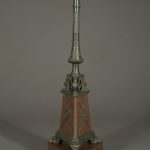

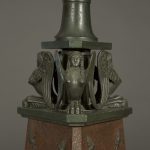
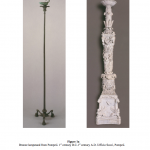

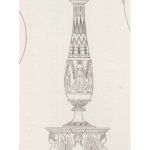
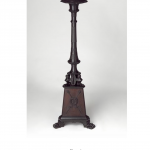
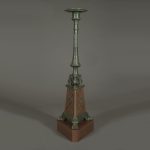
Comments are closed.